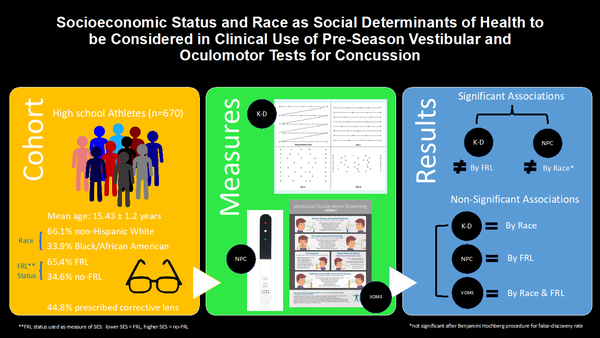-
Home
-
About JCTR
-
Gold Open Access
-
Issues
-
Editorial board
-
Author guidelines
-
Publication fees
-
Online first
-
Special issues
-
News
-
Publication ethics
-
Partners
-
Submit your manuscript
-
Submit your review report
-
Editorial Office
-

This work is licensed under a Creative Commons Attribution-NonCommercial 4.0 International License. ISSN print: 2382-6533 ISSN online: 2424-810X
Volume 6 Issue 5
Socioeconomic status and race as social determinants of health to be considered in clinical use of pre-season vestibular and oculomotor tests for concussion
Jessica Wallace, Phillip Worts, Ryan Moran, Justin Mason, Katherine K. Weise, Mark Swanson, Nicholas Murray
Wallace et al. J Clin Transl Res 2020; 6(5):2
Published online: October 7, 2020
Abstract
Background: Aside from racial and socioeconomic disparities in computerized neurocognitive testing and symptomology, there is a scarcity of research representing more diverse populations on other widely used tests for concussion, including vestibular and visual assessment.
Aim: To investigate if racial and socioeconomic differences exist on baseline Vestibular Ocular Motor Screening (VOMS) and King-Devick (K-D) test performance in high school student-athletes.
Methods: A total of 670 participants (66.1% White, 33.9% Black) with a mean age of 15.43±1.2 years were administered a baseline VOMS, average NPC distance, and K-D test. The exposure variables included race (White or Black) and socioeconomic status (SES), defined as free-and-reduced lunch status (FRL or No-FRL). FRL status was determined by each participant’s school SES. The outcome variables consisted of baseline VOMS item symptom provocation scores, average NPC distance and K-D baseline time. A series of Mann-Whitney U tests were performed for K-D baseline time, NPC distance, and VOMS items with FRL status or race as a between subject factor. Two multivariable linear regressions were run to assess the association of (1) K-D baseline times using FRL, race, sex, and corrected vision as variables in the model and (2) average NPC distance using FRL, race, sex, and corrected vision as variables in the model.
Results: When adjusting for multiple comparisons, FRL athletes had slower (worse) K-D times (p<.001) than non-FRL athletes. Black athletes had significantly lower mean NPC distance compared to White athletes at baseline (p=.02) and FRL status athletes reported a significantly greater (worse) mean symptom provocation following the visual motion sensitivity (VMS) item on the VOMS (p=.02); however, these findings were no longer significant following adjustments for multiple comparisons. No differences were noted for any remaining VOMS items. The first model explained 3.9% of the total variance of K-D baseline times whereas the second model was not significant.
Conclusions: Racial and SES differences existed on average NPC distance, and the K-D test at baseline. Possible explanations for group differences may be neurobiological, anatomical, and/or disparity in nature. With a higher probability of undiagnosed and uncorrected vision impairment, vestibular dysfunction, and saccadic eye tracking deficits likely to be more apparent as a consequence of poverty or health inequities, it is important that healthcare providers, especially those that diagnose and treat concussions, understand that performance on the VOMS and K-D tests at baseline may be subject to sociodemographic factors of SES and race.
Relevance for Patients: To provide the most culturally competent care, clinicians should consider sociodemographic variables of race and SES as social determinants of health worthy of attention on objective and subjective measures of baseline concussion assessment.

DOI: http://dx.doi.org/10.18053/jctres.06.202005.002
Author affiliation
1. University of Alabama – Department of Health Science, 270 Kilgore Lane, Capital Hall 2106, Tuscaloosa, AL 35405
2. Tallahassee Orthopedic Clinic 3334 Capital Medical Blvd Suite 600 Tallahassee, FL 32308
3. Florida State University - Department of Nutrition, Food and Exercise Sciences, Tallahassee, FL
32308
4. Florida State University Institute of Sports Sciences & Medicine Tallahassee, FL 32308
5. University of Florida – Department of Occupational Therapy, 1225 Center Drive, Room 2119
Gainesville, FL 32611
6. University of Alabama-Birmingham School of Optometry, 1716 University Blvd, Henry Peters Building 506, Birmingham, AL 35233
7. University of Nevada, Reno – School of Community Health Sciences, 1664 N. Virginia Street m/s 0274, Reno, NV 89557
*Corresponding author
Jessica Wallace
University of Alabama – Department of Health Science 270 Kilgore Lane, Capital Hall 2106 Tuscaloosa, AL 35405
Tel: (o) 205-348-4577 / (f) 205-348-7568
Email: Jswallace1@ua.edu
Handling editor:
Michal Heger
Department of Pharmaceutics, Utrecht University, the Netherlands
Department of Pharmaceutics, Jiaxing University Medical College, Zhejiang, China

